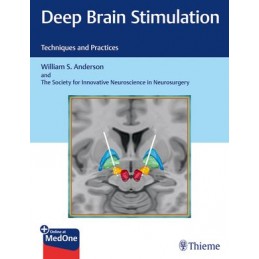- Reduced price

Order to parcel locker

easy pay


 Delivery policy
Delivery policy
Choose Paczkomat Inpost, Orlen Paczka, DHL, DPD or Poczta Polska. Click for more details
 Security policy
Security policy
Pay with a quick bank transfer, payment card or cash on delivery. Click for more details
 Return policy
Return policy
If you are a consumer, you can return the goods within 14 days. Click for more details
The one-stop resource on deep brain stimulation for functional neurosurgeons!
Deep brain stimulation (DBS) is used to modulate dysfunctional circuits in the brain with stimulation pulses applied to specific target areas of the brain. Globally, DBS procedures have been most commonly performed for Parkinsons disease and essential tremor, but there are now new and growing research efforts studying DBS for psychiatric disorders and epilepsy.
Deep Brain Stimulation:: Techniques and Practices written by the Society for Innovative Neuroscience in Neurosurgery along with Dr. William S. Anderson and distinguished experts presents the latest DBS approaches. The book begins with a history of DBS, general frame-based techniques, patient selection primarily for movement disorders, multidisciplinary collaboration, and ethical considerations. Subsequent chapters detail diverse technologies and disease-specific treatment for Parkinsons disease, essential tremor, dystonia, OCD, epilepsy, major depression, Tourette syndrome, emerging psychiatric indications, and pediatric applications.
Key highlights
DBS has helped thousands of patients with intractable conditions, allowing for a programmable therapy with durable treatment effect. This remarkable guide provides the essentials for functional neurosurgeons to pursue intraoperative research opportunities in this growing subspecialty and incorporate DBS into clinical practice.
This book includes complimentary access to a digital copy on https://medone.thieme.com.
Data sheet
Chapter 1: Introduction to Deep Brain Stimulation: History, Techniques, and Ethical Considerations
Chapter 2: Customized Platform-Based Stereotactic DBS Lead Placement Technique (FHC STarFix, Medtronic Nexframe, and Robotic System Placement)
Chapter 3: Microelectrode Recording Methods
Chapter 4: Intraoperative Imaging-Based Lead Implantation
Chapter 5: Lesioning Methods for Movement Disorders
Chapter 6: Computational Modeling and Tractography for DBS Targeting
Chapter 7: Closed-Loop Stimulation Methods: Current Practice and Future Promise
Chapter 8: Parkinsons Disease Application
Chapter 9: Essential Tremor Application
Chapter 10: Deep Brain Stimulation for Dystonia—Clinical Review and Surgical Considerations
Chapter 11: Deep Brain Stimulation for Obsessive Compulsive Disorder
Chapter 12: Deep Brain Stimulation in Epilepsy
Chapter 13: Deep Brain Stimulation in Major Depression
Chapter 14: Deep Brain Stimulation in Tourette Syndrome
Chapter 15: Deep Brain Stimulation for Emerging Psychiatric Indications
Chapter 16: Intraoperative Research during Deep Brain Stimulation Surgery
Chapter 17: Deep Brain Stimulation: Techniques and Practice for Pediatrics Indications
Chapter 18: Establishing a Deep Brain Stimulation Practice
